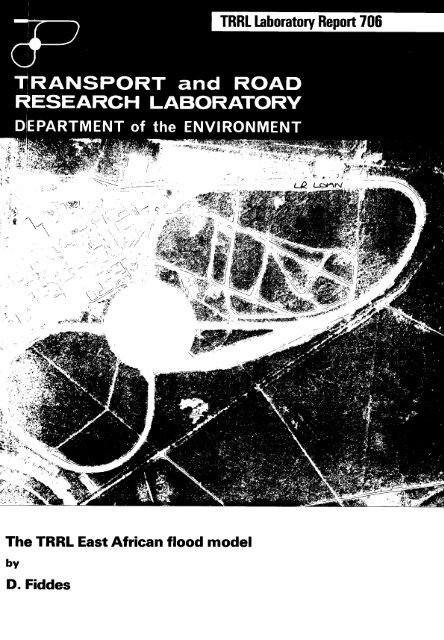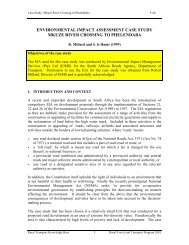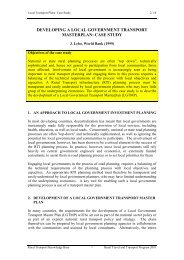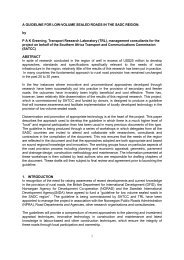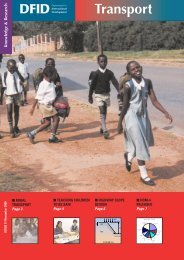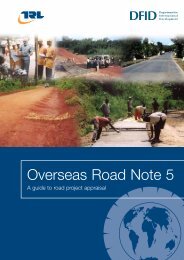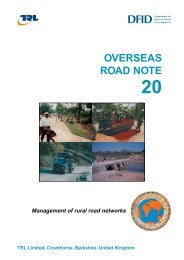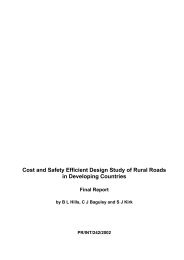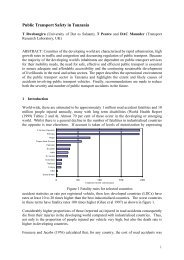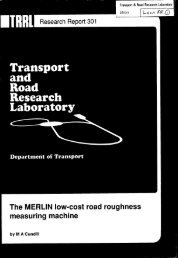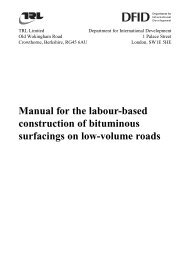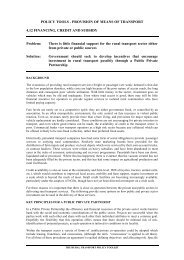LR706 East African Flood Model_ Fiddes - Transport for Development
LR706 East African Flood Model_ Fiddes - Transport for Development
LR706 East African Flood Model_ Fiddes - Transport for Development
You also want an ePaper? Increase the reach of your titles
YUMPU automatically turns print PDFs into web optimized ePapers that Google loves.
TRANSPORT and ROAD<br />
RESEARCH LABORATORY<br />
Department<br />
of the Environment<br />
TRRL LABORATORY REPORT 706<br />
THE TRRL EAST AFRICAN FLOOD MODEL<br />
by<br />
D <strong>Fiddes</strong><br />
Any views expressed in this Report are not necessarily<br />
those of the Department of the Environment<br />
Environment Division<br />
<strong>Transport</strong> Systems Department<br />
<strong>Transport</strong> and Road Research Laboratory<br />
Crowthorne, Berkshire<br />
1976<br />
ISSN 0305–1 293
CONTENTS<br />
Page<br />
Abstract<br />
1<br />
1.<br />
Introduction<br />
1<br />
2.<br />
Catchment<br />
<strong>Model</strong>s<br />
1<br />
2.1 The unit hydrography<br />
2.2 Conceptual models<br />
2.3 Analogue models<br />
1<br />
2<br />
2<br />
3.<br />
The TRRL<br />
<strong>Flood</strong> <strong>Model</strong><br />
3<br />
3.1 Description of model<br />
3.2 Finite difference equations <strong>for</strong> channel flow<br />
3.3 Stability<br />
3.4 <strong>Model</strong> calibration and proving<br />
3.5 Error functions<br />
3.6 <strong>Model</strong> calibrations<br />
3<br />
4<br />
5<br />
6<br />
6<br />
6<br />
4.<br />
Generalisation<br />
of <strong>Flood</strong> <strong>Model</strong><br />
7<br />
4.1 Form of model<br />
4.2 Initial retention (~<br />
4.3 Contributing area coefficient (CA)<br />
4.4 Catchment lag times (K)<br />
4.5 Base time<br />
7<br />
8<br />
9<br />
9<br />
10<br />
5.<br />
Summary<br />
of Design Method<br />
11<br />
6.<br />
7.<br />
8.<br />
9.<br />
Discussions and Conclusions<br />
Acknowledgements<br />
References<br />
Appendix 1. Derivation of Finite Difference Equations<br />
12<br />
13<br />
13<br />
22<br />
10.<br />
Appendix<br />
2. Worked Example<br />
24<br />
@CROWN COPYRIGHT 1976<br />
Extracts from the text may be reproduced, except <strong>for</strong><br />
commercial purposes, provided the source is acknowledged
THE TRRL EAST AFRICAN FLOOD MODEL<br />
ABSTRACT<br />
Four years ofdata from 13small representative rural catchmentsin<br />
Kenya and Uganda were analysed to develop improved methods of<br />
flood estimation <strong>for</strong>highway bridges and culverts. Dueto the short<br />
period of record and the very quick response time of the catchments,<br />
Unit Hydrography techniques were found inappropriate. A technique<br />
which made better use of limited data, there<strong>for</strong>e, had to be<br />
developed. Rainfall and runoff were fitted to a simple three parameter<br />
conceptual catchment model. The model was then used to<br />
predict the 10 year flood using a 10 year design storm. A simple<br />
technique is then developed <strong>for</strong> predicting the peak flow and base<br />
time of design hydrography <strong>for</strong> ungauged catchments.<br />
1. INTRODUCTION<br />
A large proportion of the total cost of building a road in <strong>East</strong> Africa is <strong>for</strong> the construction of bridges and<br />
culverts to cross streams from small catchmentsl. Wereas most of the larger rivers in <strong>East</strong> Africa have flow<br />
measuring stations, very few smaller streams are so equipped. Design methods must there<strong>for</strong>e be based on<br />
rainfall-runoff models.<br />
Very few data are available <strong>for</strong> the development of suitable flood models. In 1966 the Kenya and Uganda<br />
Governments and the UK <strong>Transport</strong> and Road Research bboratory co-operated in a project to instrument 12<br />
representative catchrnents, results from which could be used to develop improved flood design methods. The<br />
choice of location and instrumentation of these catchments is described elsewhere 2. This report describes the<br />
programme of analysis of results and the design method that was developed. It was presented as a paper to a<br />
Hood Hydrology Symposium in Nairobi, Kenya in October 1975 which was jointly sponsored by the Economic<br />
Commission <strong>for</strong> Africa, the <strong>East</strong> <strong>African</strong> Community and the <strong>Transport</strong> and Road Research bboratory.<br />
2. CATCHMENT MODELS<br />
A number of possible rainfall-runoff models were considered,<br />
2.1 The unit hydrography<br />
A unit hydrography is a hydrography of unit volume resulting from a rainstorm of unit duration and<br />
specified areal pattern. Hydrography <strong>for</strong> other storms of similar areal pattern can be constructed by superimposing<br />
hydrography, suitably offset in time with ordinates proportional to the flow assumed to result from<br />
the rainfall in each unit time period.<br />
It will be seen that the unit hydrography simply distributes the runoff in time. The volume of runoff must<br />
be estimated separately and this generally involves deriving a rainfall-runoff correlation.
The simplest rainfall-runoff correlation is a plot of average rainfall over the catchment and resulting<br />
runoff. Typically the relationship is slightly curved indicating a somewhat higher percentage runoff with higher<br />
rainfall totals. The scatter of the points about the regression line is often large but may be decreased by introducing<br />
additional variables such as antecedent catchment wetness and intensity of rainfall.<br />
The difference between the total rainfall and runoff is assumed to be water held on the surface of the<br />
ground or vegetation, which subsequently evaporates, or infiltration which does not appear in the stream flow<br />
until the storm runoff has effectively finished. These losses tend to be greater at the start of the storm, although<br />
to simplify the estimation of the rainfall input to the unit hydrography they are often assumed to occur at a<br />
constant rate.<br />
Their acceptance as standard practice shows that such methods have been remarkably successful, considering<br />
their simplicity, but they have two drawbacks <strong>for</strong> the present study.<br />
(a) An adequate rainfall-runoff correlation requires a large number of storm data including many<br />
producing<br />
high flows.<br />
(b) Storms that can be used to derive unit hydrography, ie high intensity storms of unit duration, are<br />
rare, particularly on small catchments where the unit time is short compared to the typical storm<br />
length.<br />
A method where more effective use can be made of the limited data that can be collected in a few years was<br />
there<strong>for</strong>e required <strong>for</strong> this study.<br />
2.2 Conceptual models<br />
A water balance <strong>for</strong> a catchment maybe envisaged of the <strong>for</strong>m<br />
R= P–E– AM– AG<br />
. . . 1<br />
where<br />
R = runoff<br />
P = precipitation<br />
E = evaporation<br />
A M = change in soil moisture<br />
A G = recharge to deep storage<br />
If records are available <strong>for</strong> precipitation, models can be set up to compute a running sequence of values<br />
<strong>for</strong> the other terms on the right hand side of the equation thus giving a running sequence of runoff values which<br />
can be suitably distributed in time. The best known example of this type of model is the Stan<strong>for</strong>d watershed<br />
mode13.<br />
Complicated computer programs and considerable data <strong>for</strong> calibration purposes are required which make<br />
this approach inappropriate <strong>for</strong> the present study.<br />
2.3 Analogue models<br />
The similarity between the response of a catchment to storm rainfall and the flow through a series of<br />
reservoirs has been noted by many workers. Zoch suggested the concept of linear reservoir routing as early as<br />
2
1934. The response of cascading flows through a number of linear reservoirs both in series and parallel was<br />
studied<br />
by Sugawara and Marayamas.<br />
The purpose of this study is to develop a model which can be applied to ungauged catchments using very<br />
few measurements of catchment characteristics such as area, slope, soil type. The model must there<strong>for</strong>e be<br />
simple and have a limited number of parameters. The lumping or averaging of certain catchment mechanisms<br />
inherent in a simple reservoir model is thus not a disadvantage. ~ls was there<strong>for</strong>e considered to be the most<br />
suitable type of model <strong>for</strong> the <strong>East</strong> Africa study.<br />
3. THE TRRL FLOOD MODEL<br />
3.1 Description of model<br />
The model is made up of two parts. A linear reservoir model is used <strong>for</strong> the period between the rain<br />
hitting the ground surface and the floodflow entering the stream system (the “land phase”) and a finite<br />
difference routing technique is used <strong>for</strong> the passage of the flood wave down the river to the catchment outfall.<br />
A reservoir is said to be linear if the outflow<br />
linear relationship<br />
(q) is related to the water stored in the reservoir by the<br />
1s q=K . . . 2<br />
where<br />
S is the reservoir storage<br />
K is the reservoir lag time<br />
The flow from a linear reservoir with zero inflow decreases exponentially. The lag time maybe conveniently<br />
thought of as the time required <strong>for</strong> the recession curve to fall to approximately + of its initial value.<br />
The reservoir storage contains the rain falling during the storm which contributes to the flood hydrography.<br />
This can either be surface runoff or rapid subsurface runoff (interflow). Runoff does not occur uni<strong>for</strong>mly over<br />
a catchment. Parts of the catchment are less permeable than others due to variation in soil type, or, in low<br />
lying areas, to slower drying out after previous rain. A uni<strong>for</strong>m runoff coefficient can there<strong>for</strong>e be misleading<br />
and recently the concept of catchment contributing area (CA) has been substituted.<br />
Between storms, drying of the soil takes place due to the combined effects of evaporation and plant<br />
transpiration. The drying takes place principally in the surface layers. This accounts <strong>for</strong> the high infiltration<br />
rate at the start of a storm and also <strong>for</strong> the lack of subsurface runoff until this loss has been made good by<br />
infiltration. This is modelled by a storage called initial retention (~, which must be filled be<strong>for</strong>e flood runoff<br />
occurs.<br />
The simple land phase model may there<strong>for</strong>e be summarised as:<br />
(a) firly rain fills the initial retention (~. Runoff at this stage is zero.<br />
(b) Subsequent rain falling on the parts of the catchment from which runoff will occur (CA) enters<br />
the reservoir storage.<br />
3
(c) Runoff is given by equation (2).<br />
This simple model, and derivations from it, were compared with the unit hydrography using data from a<br />
small catchment<br />
7. The results were very promising.<br />
With small catchments the attenuation of the flood hydrography during travel down the stream system is<br />
ne~igible. For larger catchments it can be considerable. It has been suggested that these translation effects<br />
can be allowed <strong>for</strong> by varying the reservoir lag time (K)s.<br />
This was attempted when data from the larger catchments were analysed but poor results were obtained.<br />
In addition, if the value of the lag time is dependent on catchment size, values obtained <strong>for</strong> small catchments<br />
are difficult to apply to large catchments.<br />
The approach finally adopted was to divide the catchment into a number of sub-catchments, the runoff<br />
from which was simulated using the land phase model. The translation of this runoff down the stream system<br />
to the catchment outfall was modelled using a modification of the finite difference technique developed by<br />
Morgali and Linsley9.<br />
3.2 Finite difference equations <strong>for</strong> channel flow<br />
h exact mathematical solution of the equations describing the generation of a flood hydrography in a<br />
stream system is not possible. Finite difference techniques can be used to get approximate solutions. The<br />
principle by which they operate is that very simple equations are adequate to describe the flow over very short<br />
distances and times. It follows that accurate solutions by this method <strong>for</strong>whole catchments would involve<br />
many repetitions of the calculations. This would be very tedious if done by hand but is quite feasible by<br />
digital computer.<br />
~agrammatic<br />
view of a reach of the stream:<br />
(2)<br />
(1)<br />
SECTION OF STREW<br />
Lines 1 and 2 represent the water surface at times separated by a time increment At. L, M and R are subscripts<br />
which define three stations on line 1. P is the subscript of the middle station on line 2.<br />
4
If the depth and velocities at the stations on line 1 are all known together with the lateral inflow from<br />
the linear reservoir, by moving progressively down the stream, the depths and velocities along line 2 can be<br />
computed using the momentum and continuity equations. The derivation of the appropriate finite difference<br />
equations is given in Appendix 1.<br />
calculated<br />
From the diagram it will be seen that values <strong>for</strong> the extreme upstream and downstream stations are not<br />
and have to be estimated.<br />
For the uppermost reach the upstream velocities and depths are assumed zero.<br />
For lower reaches the upstream values are assumed to be the same as the downstream values <strong>for</strong> the<br />
previous reach.<br />
At junctions the following equations apply<br />
A1+A2=A3<br />
Q1+Q, =Q3<br />
where A = cross sectional area<br />
Q = flOW<br />
and subscripts<br />
1, 2 and 3 refer to the three reaches <strong>for</strong>ming the junction.<br />
The values <strong>for</strong> the downstream station of each reach are calculated by extrapolation of the values <strong>for</strong> the<br />
two immediately upstream stations.<br />
A flow diagram <strong>for</strong> the computer program is shown in Fig 1.<br />
3.3 Stability<br />
Finite difference equations are only approximations and the accuracy of the solutions is dependent on<br />
the incremental length and times chosen. Morgali and Llnsleyg show that the equations will become unstable<br />
and errors will be introduced unless the following equation is satisfied.<br />
3<br />
where V =<br />
Y=<br />
g=<br />
velocity<br />
depth<br />
acceleration<br />
due to gravity<br />
Ax and At are the chosen distance<br />
and time increments.<br />
Typical values <strong>for</strong> the initial incremental distance and times were 200m and 30s.<br />
The instability takes the <strong>for</strong>m of oscillations or waves in the recession part of the predicted hydrography.
In the discussion of Morgali and tinsley’s paper 10 several people pointed out that satisfying equ (3) did<br />
not automatically ensure that the equation would be stable. This was found to be correct. In the analysis,<br />
instability did occur on occasions, even if equ (3) were satisfied. This was particularly so <strong>for</strong> very steep catchments<br />
or <strong>for</strong> catchments with very large reservoir lag (K) values.<br />
Tests were there<strong>for</strong>e incorporated in the program to establish when instability was occtiing. The run<br />
was terminated and repeated with the time increment At reduced by a factor of two.<br />
3.4 <strong>Model</strong> calibration and proving<br />
To run the program <strong>for</strong> a given storm the required input is:<br />
(a) The recorded rainfall <strong>for</strong> each 15 minute period<br />
(b) The recorded streamflow hydrography ordinates<br />
(c)<br />
For each reach - area, length, slope, K, Y, CA,<br />
Manning’s “n”, Ax, At.<br />
The model works on At time intervals but assumes that the rainfall intensity is constant over a 15 minute<br />
period. For a singe gauge, rainfall can be measured to a finer time scale, but when several raingauges are<br />
being averaged this is unjustified.<br />
3.5 Error functions<br />
For each combination of values of the parameters, a hydrography is predicted. The ordinates of this<br />
hydrography are compared with the ordinates of the recorded hydrography and an error function calculated.<br />
A small error function indicates close agreement between predicted and recorded hydrography. The error<br />
function adopted was the usual sum of the squares of the ordinate differences.<br />
ERF = ~ (y – YO)2<br />
where y is a predicted ordinate and<br />
y. is a recorded ordinate.<br />
To avoid undue significance being given to the larger storms a second error function was calculated,<br />
This compared the mean weighted ordinate error to the mean recorded ordinate.<br />
Per cent ordinate error = m ,,,,<br />
70<br />
where n = number of ordinates<br />
To. = mean of recorded ordinates<br />
3.6 <strong>Model</strong> calibration<br />
Approximately 4 years of data were available <strong>for</strong> each catchment. For most catchments these included<br />
a number of large storms, but, inevitably with such short periods of research, on some catchments only
elatively small storms were recorded. The model was run <strong>for</strong> each large storm on a catchment and <strong>for</strong> a<br />
variety of values of the parameters K and CA. The combinations giving the best agreement between recorded<br />
and predicted floods are listed in Table 1.<br />
4. GENERALISATION OF FLOOD MODEL<br />
4.1 Form of model<br />
The flood model had now been calibrated <strong>for</strong> each catchment. To develop a general flood model the<br />
differences in catchment response to rainfall shown by the individual catchments was next examined. As the<br />
recorded storms varied in severity it was necessary to use the model <strong>for</strong> each catchment to simulate a flood of<br />
a known recurrence interval be<strong>for</strong>e a comparison could take place. A 10 year flood was selected <strong>for</strong> comparison.<br />
~s was simulated by using a 10 year storm profile (see ref 11) and appropriate values <strong>for</strong> the model parameters<br />
K, CA and Y (see 4.2 – 4.4). The results appear in Table 2.<br />
Hydrography, recorded and predicted <strong>for</strong> the largest storms and <strong>for</strong> 10 year floods are shown <strong>for</strong> each<br />
catchment in Figs 2 – 13.<br />
Once estimates of the parameters Y, CA, and K have been made <strong>for</strong> a catchment a design flood could be<br />
estimated by routing a design storm through the computer program. This can be a time consuming process and<br />
<strong>for</strong> many purposes a simpler technique is required. From CA and Y the volume of runoff from any given<br />
design storm can be calculated and if the hydrography shape can be related to the catchment lag time (K), the<br />
peak flow can dso be estimated.<br />
Many research workers have published “dimensionless hydrography” and it has been shown17 that in the<br />
United States these approximate closely to the equation<br />
L 4<br />
where Q = discharge at time T after start of rise<br />
Qm = peak discharge<br />
Tm = time to peak<br />
. . . 4<br />
The most widely used dimensionless hydrography is that of the US Soil Conservation, Service l’. For arid<br />
areas Hickok et alls suggest a somewhat<br />
more peaked shape.<br />
For all of these the ratio of time to peak to base time are very similar. This was not found to be true <strong>for</strong><br />
the <strong>East</strong> <strong>African</strong> catchments studied. For consistency the base time was assumed to be the time from 1 per<br />
cent of peak flow on the rising limb to 10 per cent of peak flow on the falling limb of the hydrography.<br />
Mfined this way, the ratio base time : time to peak is approximately 3.0 <strong>for</strong> the US hydrography. For the<br />
<strong>East</strong> <strong>African</strong> catchments it varied between 2.7 and 11.0. The use of a sin#e hydrography based on time to peak<br />
was there<strong>for</strong>e not appropriate.<br />
A much more stable ratio was found to be the peak flow (Q) divided by the average flow measured over<br />
the base time (~) (Peak How Factor F)<br />
7
Q<br />
. . . 5<br />
This is the factor used by Rodier and Auvraylg in West Africa. For very short lag times (K ~ 0.2h) F was<br />
2.8 * 10%. For all lag times greater than 1 hour, F was 2.3 * 10%. These figures hold true <strong>for</strong> the catchment<br />
results and were confirmed by a simulation exercise in which area, slope, lag time and contributing area<br />
coefficient were systematically varied.<br />
The peak flow can there<strong>for</strong>e be simply estimated if the average flow during the base time of the hydrographycan<br />
be calculated.<br />
The total volume of runoff is given by:<br />
RO =<br />
(p-~cA.A.lo3(m3)<br />
. . . 6<br />
where P =<br />
Y=<br />
CA =<br />
A=<br />
storm rainfall (mm) during time period equal to the base time<br />
initial retention (mm)<br />
contributing area coefficient<br />
catchment area (kmz )<br />
If the hydrography base time is measured to a point on the recession curve at which the flow is ~ th of the<br />
peak flow then the volume under the hydrography is approximately 7 per cent less than the total runoff given<br />
by equ (6).<br />
The average flow (c) is there<strong>for</strong>e given by:<br />
Q=<br />
0.93 . RO<br />
3600 . TB<br />
. . . 7<br />
where TB = hydrography base time (hrs)<br />
Estimates of Y and CA are required to calculate RO and lag time K to calculate TB. These will now be<br />
discussed in turn.<br />
4.2 Initial retention (Y)<br />
For the model fitting to the storms listed in Table 1 an appropriate initial retention was calculated from<br />
the balance of evapotranspiration and rainfall since the last storm to give significant runoff. This procedure<br />
could not be applied to the Mudanda catchment. Here a value of approximately 5mm was found appropriate.<br />
This is typical of arid zone catchments12.<br />
The probability of the soil on a catchment anywhere in <strong>East</strong> Africa being at field capacity has been<br />
studied by Huddart and Woodward 13.<br />
For convenience their results are reproduced in this paper (Table 3,<br />
Figs 14 and 15). It will be seen that in the wet zones the 7 day antecedent rainfall easily exceeds the potential<br />
evapotranspiration during the same period. In the dry zones the figures are much closer but only in Western<br />
Uganda is there a high probability that the surface layers will be below field capacity. Here as in the semi arid<br />
zone, a 5mm initial retention is recommended <strong>for</strong> design purposes. Elsewhere assume zero initial retention.<br />
8
4.3 Contributing area coefficient (CA)<br />
Wen the catchrnent surface is very dry, runoff is small and only occurs from areas very close to the<br />
stream system. For storms following a wet period a larger area contributes and larger volumes of runoff occur.<br />
If the catchment were sufficiently wet, the whole area would contribute and the value of CA would approach<br />
unity. However, except on very small solid clay or rock catchments there is a practical upper limit to CA which<br />
is well below unity. Evidence <strong>for</strong> this from the USA has already been referred to6 and there is further confirmation<br />
in a recent TRRL study 14.<br />
For simplicity it is assumed that the contributing area coefficient varies linearly with soil moisture<br />
recharge until the soil reaches field capacity when the limiting value of CA is attained. Similar assumptions are<br />
made in the recent UK <strong>Flood</strong> Studies Report15.<br />
Four factors influence the size of the contributing area coefficient. These are soil type, slope, type of<br />
vegetation or Ianduse (particularly in the valley bottoms) and catchment wetness. The network of catchments<br />
had been selected to cover the range of these factors to be found in <strong>East</strong> Africa. The results could there<strong>for</strong>e be<br />
used to give indications of their effect on CA.<br />
The effect of slope and sod type was studied by comparing the results of the catchments with grass cover<br />
and the storms falling on soil at field capacity.<br />
The effect of antecedent wetness was studied by comparing the runoff volumes resulting from storms.<br />
occurring at different stages of the rainy season. The reduction in value of CA was assumed to vary linearly<br />
with the soil moisture deficit. Using Tables 1 and 3, appropriate values of the reduction in CA <strong>for</strong> design conditions<br />
<strong>for</strong> the various zones were arrived at.<br />
The effect of landuse was calculated by comparing the recorded volumes of runoff with those that would<br />
have occurred with a standard grassed catchment.<br />
The design value of the contributing area coefficient is there<strong>for</strong>e given by:<br />
CA ‘es. cw. cL . . . 8<br />
where Cs = the standard value of contributing area coefficient <strong>for</strong> a grassed catchment<br />
at field capacity<br />
Cw = the catchment wetness factor<br />
CL = the land use factor<br />
Tables <strong>for</strong> estimating these factors are given in Tables 4,5 and 6.<br />
4.4 Catchment lag times (K)<br />
In Table 2 it will be seen that there is a very large range of lag times (K). Attempts were made to obtain<br />
correlation of K with various catchment characteristics such as overland slope, contributing area and drainage<br />
density, but the only factor found to show a strong relationship was vegetation cover. The same conclusion<br />
was drawn in a similar study by Bell and Om Kar, involving results from 47 small catchments located throughout<br />
the United States16.<br />
9
The appropriate value of lag time can be estimated by reference to Table 7. In assessing which category<br />
to place a given catchment it should be remembered that generally only small areas either side of the stream<br />
are contributing to the flood hydrography. It is these areas, there<strong>for</strong>e, which must be assessed.<br />
4.5 Base time<br />
The method of estimating the base time was derived from the study referred to in section 4.1. It is made<br />
up of three parts:<br />
(a)<br />
The rainfall time<br />
(b)<br />
The recession time <strong>for</strong> the surface flow<br />
(c) The attenuation of the flood wave in the stream system.<br />
The rainfall time (Tp) is the time during which the rainfall intensity remains at high level. This can be<br />
approximated by the time during which 60 per cent of the total storm rainfall occurs. Using the general <strong>East</strong><br />
<strong>African</strong> depth duration equation.<br />
I=<br />
a<br />
(T t ;)n<br />
. . . 9<br />
where I = intensity<br />
T = duration<br />
a and n are constants<br />
The time to give 60 per cent of the total storm rainfall is given by solving the equation<br />
0.6 = ; ( 2433 )n<br />
T t 0.33<br />
. . . 10<br />
Values <strong>for</strong> the various rainfall zones of <strong>East</strong> Africa are given in Table 8.<br />
The time <strong>for</strong> the outflow from a linear reservoir to fall to ~th of its initial value is 2.3K where K is the<br />
reservoir lag time. The recession time <strong>for</strong> surface flow is there<strong>for</strong>e 2.3K.<br />
In the simulation study, values <strong>for</strong> base time were calculated <strong>for</strong> various areas, slopes, lag times and<br />
contributing area coefficients. Knowing the rainfall time and the surface flow recession time, the additional<br />
time <strong>for</strong> flood wave attenuation (TA) can be found by difference. It was found that this could be estimated<br />
from the equation<br />
TA =<br />
0.028 L<br />
Q% ~%<br />
. . . 11<br />
where L = length of main stream (km)<br />
o = average flow during basetime (m3 /s)<br />
S = average slope along mainstream<br />
10
The base time is there<strong>for</strong>e estimated from the equation<br />
TB = Tp t 2.3K t TA . . .<br />
12<br />
The average flow (~) can be estimated. It will be noted that ~ appears in equ (11) so an iterative or<br />
trial and error solution is required. If initially TA is assumed zero, two iterations should be adequate.<br />
Knowing ~ and F the peak flow is calculated using equ (5).<br />
5. SUMMARY OF DESIGN METHOD<br />
The steps involved in estimating<br />
the peak flow <strong>for</strong> a design storm are as follows:<br />
(a)<br />
,’<br />
hcate catchment on a large scale map and measure catchment area, land slope and channel slope.<br />
The land slope is estimated by superimposing a grid over the catchment and measuring the minimum<br />
distance between contours at each grid point. From these slopes are calculated and averaged to<br />
give the mean catchment value. The channel slope is the average slope from the bridge site to the<br />
uppermost part of the stream. Where in<strong>for</strong>mation is sparse this may be taken as 85 per cent of the<br />
distance to the watershed.<br />
(b)<br />
From site inspection establish catchment type in Table 7 and hence lag time (K).<br />
(c)<br />
From site inspection or using Fig 15 establish soil type and with land slope estimate the standard<br />
contributing area coefficient (Cs) in Table 4<br />
(d)<br />
Using Fig 14 fix antecedent rainfall zone. Check in Table 3 to see if zone is wet, dry or semi-arid.<br />
(e)<br />
Estimate catchment wetness factor from Table 5.<br />
(0<br />
From site inspection decide on type of vegetative cover, paying particular attention to areas close<br />
to the stream. Using table 6 estimate land use factor (Cd.<br />
(g)<br />
Contributing area coefficient (CA) is given by:<br />
CA= CS. CW. CL<br />
(h)<br />
If antecedent rainfall zone in (d) above is semi-arid or West Uganda, initial retention (~ is 5mm.<br />
For all other zones, Y = O.<br />
(i)<br />
Using Fig 16 and Table 8, estimate<br />
rainfall time (Tp).<br />
6)<br />
Using methods outlined inref(11) calculate the design storm rainfall to be allowed <strong>for</strong> during<br />
time interval TB hours (P mm).<br />
(k)<br />
The volume of runoff is given by equ (6).<br />
RO = CA. (p–~. A.103(m3)<br />
11
~) The average flow is given by<br />
~ = 0.93 . RO<br />
3600 . TB<br />
. . . 13<br />
(m) Recalculate base time<br />
TB = Tp + 2.3K + TA<br />
0.028 L<br />
where TA=—<br />
~%~%<br />
(n)<br />
Repeat steps Q) to (m) until C is within 5 per cent of previous estimate.<br />
(o)<br />
Design peak flow (Q) is given by<br />
Q=F. ~<br />
where peak flood factor (F) is:<br />
F = 2.8 K less than 0.5 hour<br />
F = 2.3 K more than 1 hour<br />
Table 9 indicates the accuracy achieved in using the method <strong>for</strong> the network catchments.<br />
A worked example is given in Appendix 2.<br />
6. DISCUSSION AND CONCLUSIONS<br />
A reservoir analogue model has been developed which can be used to improve the usefulness of limited catchment<br />
data.<br />
This has been used to derive a simple method of flood prediction <strong>for</strong> small rural catchments in which the<br />
most critical factors are landuse and soil type.<br />
The catchments used to develop the method covered a range of landuse and soil type but inevitably<br />
could not cover all the combinations to be found throughout <strong>East</strong> Africa. In areas not already covered, very<br />
simple on site measurements by engineers would greatly improve the accuracy and usefulness of the design<br />
technique. If a note is kept of how many hours a flood resulting from a notable rainstorm lasts, an estimate<br />
can be made of the appropriate lag time to apply using equation 12. This is the factor that has the greatest<br />
influence on peak flow.<br />
method<br />
The most commonly specified recurrence intervals <strong>for</strong> small hydraulic structures are 5 or 10 years. The<br />
has been designed to provide these figures easily.<br />
Sometimes, <strong>for</strong> larger structures, longer recurrence intervals are specified. Using the method to estimate<br />
these introduces two elements of uncertainty.<br />
(a) The shape and volume of the appropriate storm profile.<br />
12
(b) The catchment response to exceptional storms. Of these the second is the more problematical.<br />
There are a number of other problems in designing structures <strong>for</strong> very unusual floods. These include: –<br />
(a) If the total flow is channeled through a bridge opening very high scouring velocities occur which<br />
can endanger<br />
the pier foundations.<br />
(b) Very high flows uproot trees or islands of papyrus. Very often structure failure is due to spans<br />
being blocked<br />
by such debris rather than to the flow of the water itself.<br />
For the size of catchment being considered here (up to 200 km2 ) high flood flows only last <strong>for</strong> a few<br />
hours. If the structure itself can be safeguarded, designing <strong>for</strong> flows of greater than 10 year recurrence interval<br />
could we~ be uneconomic.<br />
From the above considerations it is recommended that where possible designs are standardised at a 10<br />
year recurrence interval with provision <strong>for</strong> larger flows to bypass the structure with safety. An example would<br />
be to provide approach embankments at a level lower than the bridge deck, thus giving a safe flood spillway<br />
and effectively limiting the velocity of flow through the bridge opening.<br />
7. ACKNOWLEDGEMENTS<br />
The work described in this report <strong>for</strong>ms part of the programme of the Environment Division (Head – Mr L H<br />
Watkins) in the <strong>Transport</strong> Systems Department of the UK <strong>Transport</strong> and Road Research bboratory and was<br />
carried out on behalf of the UK Ministry of Overseas <strong>Development</strong>. The equipment in the experimental catchments<br />
was installed and operated <strong>for</strong> TRRL by the Water <strong>Development</strong> Departments of the Kenya and Uganda<br />
Governments. The help and assistance of the Director and Commissioner are gratefully acknowledged.<br />
8. REFERENCES<br />
1.<br />
TRURAN, R J. The needs of the consulting engineer. ECA Hood Hydrology Symposium, Nairobi 1975.<br />
2.<br />
FIDDES, D and J A FORSGATE. Representative rural catchments in Kenya and Uganda. Department<br />
of the Environment, TRRL Report LR 318. Crowthorne, 1970 (<strong>Transport</strong> and Road Research Laboratory).<br />
3.<br />
CRAWFORD, N H and R K LINSLEY. The synthesis of continuous streamflow hydrography on a digital<br />
computer. Stan<strong>for</strong>d University Technical Report No. 12.1962.<br />
4.<br />
ZOCH, R T. On the relation between rainfall and streamflow. Monthly Weather Review. Vol 62.<br />
pp 31 5–322. 1934.<br />
5.<br />
SUGAWARA, M and F MARAYAMA. A method of prevision of the River Discharge by means of a rainfa~<br />
model. Publ No 42, IASH Symposium Darcy. Vol 3. pp 71–76. 1956.<br />
6.<br />
BETSON, R P. What is watershed runoffl Journal Geophysical Research, Vol 69. April 1964.<br />
13
7. FIDDES; D. A reservoir model alternative to the unit hydrography <strong>for</strong> flood estimation. Department of<br />
the Environment, TRRL Report LR554. Crowthorne, 1973. (<strong>Transport</strong> and Road Research bboratory).<br />
8. LAURENSON, EM. A catchment storage model <strong>for</strong> runoff routing. Journal of Hydrology. Vol 2.<br />
pp 144–163. 1964.<br />
9. MORGALI, J R and R K LINSLEY. Computer analysis of overland flow. Proc ASCE (Hyd Div). HY3.<br />
pp 81–100. May, 1965.<br />
10. Discussion of Ref (9). Proc ASCE (Hyd Div) HY6 pp 224–238. Nov 1965.<br />
11. FIDDES, D. Design storms <strong>for</strong> <strong>East</strong> Africa ECA <strong>Flood</strong> Hydrology Symposium. Nairobi 1975.<br />
12. FOGEL, M M and L DUCKSTEIN. Prediction of convective storm runoff in semi-arid regions. Symposium<br />
on Representative and experimental watersheds. IASH Publ No 96. pp 465–478. New Zealand<br />
1970.<br />
13. HUDDART, L and P G WOODWARD. The prediction of antecedent catchment wetness. ECA <strong>Flood</strong><br />
Hydrology Symposium. Nairobi 1975.<br />
14. FORD, W G. The adaptation of the RRL Hydrography method <strong>for</strong> tropical conditions. ECA <strong>Flood</strong><br />
Hydrology Symposium. Nairobi 1975.<br />
15. NATIONAL ENVIRONMENTAL RESEARCH COUNCIL. <strong>Flood</strong> Studies Report. London 1975.<br />
16. BELL, F C and S OM KAR. Characteristic response times in design flood estimation. Journal of<br />
Hydrology. Vol VIII. No 2. pp 173–196. 1969.<br />
17. LINSLEY, R K, M A KOHLER and J L PAULHUS. Hydrology <strong>for</strong> engineers. McGraw-Hill. 1958.<br />
18. HICKOK R B, R U KEPPEL and B R RAFFERTY. Hydrography synthesis <strong>for</strong> small arid watersheds.<br />
Agricultural Engineering. pp 608–615. October 1959.<br />
19. RODIER, J A and C AUVRAY. Preliminary general studies of floods on experimental and representative<br />
catchment areas in tropical Africa. IASH Symposium of Budapest. 1965. Vol 1. pp 22–38.<br />
14
TABLE 1<br />
Details of storms and summary<br />
of analysis<br />
Catchment<br />
TIWI<br />
MUDANDA<br />
MI GWANI<br />
KAJIADO<br />
ESERET<br />
KIAM<br />
BU I<br />
KIAMBU 11<br />
SAOSA<br />
BARABILI<br />
MUNYERE<br />
SUB<br />
RUBAARE<br />
LUGULA<br />
Date<br />
of<br />
Storm<br />
21/4/70<br />
9/5/72<br />
11/5/72<br />
6/7/12<br />
Z6/11/69<br />
14/4/71<br />
1/12/71<br />
2/12/71<br />
4/1 1/72<br />
11/11/72<br />
19/11/72<br />
i4/1 1/69<br />
i3/11/71<br />
2/12/71<br />
!0/12/71<br />
15/11/72<br />
2/6/10<br />
1/6/71<br />
!2/12/71<br />
!5/12/71<br />
23/4/70<br />
16/2/73<br />
19/2/73<br />
22/2/73<br />
3/12/68<br />
1/5/71<br />
16/5/71<br />
3/5/72<br />
11/5/72<br />
3/6/72<br />
16/3/58<br />
20/5/60<br />
4/7/60<br />
12/5/61<br />
!9/12/62<br />
1 6/8/66<br />
19/8/70<br />
28/8/71<br />
18/7/71<br />
6/10/71<br />
2/11/71<br />
8/11/71<br />
4/3/72<br />
25/4/70<br />
26/2/72<br />
1/11/69<br />
27/3/70<br />
1/2/72<br />
~ainfa<br />
mm<br />
104.7<br />
58.0<br />
98.9<br />
27.4<br />
14.9<br />
27.5<br />
17.2<br />
20.5<br />
15.8<br />
10.8<br />
22.1<br />
60.4<br />
96.7<br />
66.2<br />
35.4<br />
53.9<br />
24.2<br />
26.4<br />
71.5<br />
64.6<br />
58.2<br />
43.5<br />
67.0<br />
20.6<br />
63.2<br />
45.0<br />
37.7<br />
16.1<br />
12.1<br />
53.6<br />
116.6<br />
25.0<br />
32.2<br />
28.1<br />
45.4<br />
49.5<br />
74.8<br />
01.8<br />
41.1<br />
15.5<br />
24.2<br />
52.3<br />
17.3<br />
89.6<br />
05.2<br />
28.7<br />
42.9<br />
30.8<br />
Peak<br />
flow<br />
n3 see-l<br />
0.289<br />
1.428<br />
5.836<br />
0.354<br />
0.680<br />
0.810<br />
0.370<br />
0.710<br />
0.540<br />
0.340<br />
0.370<br />
59.770<br />
41.930<br />
59.770<br />
75.640<br />
39.320<br />
0.771<br />
0.431<br />
2.011<br />
4.181<br />
2.560<br />
0.960<br />
3.260<br />
0.940<br />
0.097<br />
0.018<br />
0.038<br />
0.053<br />
0.068<br />
0.435<br />
0.642<br />
0.140<br />
0.250<br />
0.156<br />
0.140<br />
0.171<br />
0,235<br />
0.751<br />
0.310<br />
0.190<br />
0.300<br />
0.680<br />
0.110<br />
3.200<br />
8.300<br />
0.364<br />
0.767<br />
0.116<br />
Rainfall<br />
in<br />
prel<br />
30 Days<br />
mm<br />
Record<br />
incom<br />
Negligible<br />
Rai<br />
74.3<br />
277.5<br />
11.2<br />
108.8<br />
6.2<br />
48.9<br />
89.6<br />
20.8<br />
66.8<br />
74.9<br />
129.2<br />
12.0<br />
155.4<br />
238.4<br />
247.4<br />
85.0<br />
88.5<br />
74.7<br />
140.1<br />
113.3<br />
33.8<br />
104.9<br />
215.1<br />
338.0<br />
140.4<br />
76.5<br />
111.2<br />
102.8<br />
0.0<br />
0.0<br />
0.0<br />
0.0<br />
31.5 mm<br />
0.0<br />
199.9<br />
200.4<br />
8.4<br />
111.5<br />
i 36.0<br />
158.2<br />
76.2<br />
195.9<br />
113.2<br />
155.4<br />
241.7<br />
124.8<br />
3US<br />
7 Days<br />
mm<br />
ete<br />
but<br />
all<br />
38.8<br />
242.3<br />
11.2<br />
69,8<br />
1.5<br />
19.6<br />
60.3<br />
14.4<br />
10.7<br />
0.9<br />
89.8<br />
9.0<br />
65.3<br />
31.9<br />
75.5<br />
41.4<br />
14.9<br />
37.0<br />
90.9<br />
Two<br />
storms<br />
on 23/4<br />
0.0<br />
25.6<br />
100.8<br />
189.5<br />
100.7<br />
117.2<br />
67.2<br />
49.2<br />
18.9<br />
0.5<br />
0.0<br />
0.0<br />
0.0<br />
0.0<br />
n 28/12/62<br />
0.0<br />
63,9<br />
56.6<br />
8.4<br />
32.7<br />
48.8<br />
29.8<br />
19.7<br />
88.2<br />
11.9<br />
51.8<br />
37.1<br />
22.8<br />
hsume,<br />
Initial<br />
tetentio<br />
mm<br />
95<br />
25<br />
0<br />
15<br />
3<br />
7<br />
5<br />
8<br />
5<br />
4<br />
7<br />
3<br />
30<br />
3<br />
3<br />
3<br />
15<br />
15<br />
32<br />
0<br />
0<br />
5<br />
0<br />
5<br />
0<br />
0<br />
0<br />
0<br />
0<br />
35<br />
0<br />
0<br />
0<br />
0<br />
0<br />
0<br />
0<br />
0<br />
15<br />
2<br />
8<br />
10<br />
9<br />
0<br />
15<br />
0<br />
0<br />
0<br />
Lag<br />
Time<br />
{ Minf<br />
95<br />
80<br />
70<br />
100<br />
3<br />
3<br />
3<br />
3<br />
3<br />
3<br />
3<br />
30<br />
20<br />
20<br />
20<br />
20<br />
140<br />
140<br />
35<br />
120<br />
5<br />
5<br />
5<br />
5<br />
500<br />
500<br />
400<br />
200<br />
175<br />
150<br />
450<br />
500<br />
375<br />
450<br />
450<br />
450<br />
600<br />
400<br />
7<br />
7<br />
7<br />
7<br />
7<br />
50<br />
50<br />
450<br />
500<br />
600<br />
optimum Values <strong>for</strong> <strong>Model</strong>ling<br />
CA<br />
0.050<br />
0.050<br />
0.090<br />
0.050<br />
0.081<br />
0.080<br />
0.047<br />
0.105<br />
0.067<br />
0.067<br />
0.037<br />
0.280<br />
0.430<br />
0.380<br />
0.250<br />
0.350<br />
0.380<br />
0.130<br />
0.100<br />
0.380<br />
0.065<br />
0.029<br />
0.059<br />
0.062<br />
0.035<br />
0.006<br />
0.016<br />
0.017<br />
0.022<br />
0.080<br />
0.030<br />
0.035<br />
0.035<br />
0.030<br />
0.022<br />
0.014<br />
9.030<br />
).065<br />
).047<br />
).052<br />
).061<br />
).120<br />
).036<br />
).02 1<br />
).038<br />
).140<br />
).280<br />
).060<br />
Error<br />
‘unctior<br />
0.0359<br />
0.9842<br />
7.1360<br />
0.2061<br />
0.2000<br />
0.1800<br />
0.0200<br />
0.1500<br />
0.0800<br />
0.0400<br />
0.0200<br />
I 1944.9<br />
!6713.7<br />
!4021.6<br />
2692.1<br />
5659.9<br />
0.1846<br />
0.0799<br />
0.9810<br />
4.5280<br />
4.3300<br />
0.2300<br />
1.1800<br />
0.3100<br />
0.0033<br />
0.0008<br />
0.0017<br />
0.0024<br />
0.0019<br />
0.1807<br />
0.6090<br />
0.0122<br />
0.0124<br />
0.0556<br />
0.0056<br />
0.0535<br />
0.2855<br />
0.3620<br />
0.0100<br />
0.0000<br />
0.0200<br />
0.1900<br />
0.0000<br />
8.1900<br />
1.4000<br />
0.2717<br />
0.8892<br />
0.0304<br />
% Age<br />
Ordinate<br />
Error<br />
50.4<br />
69.6<br />
98.7<br />
47.5<br />
75.5<br />
79.2<br />
59.7<br />
84.4<br />
85,6<br />
90.2<br />
54.2<br />
67.1<br />
57.0<br />
50.2<br />
51.6<br />
33.5<br />
22.3<br />
30.8<br />
39.6<br />
17.0<br />
114.6<br />
56,6<br />
36.7<br />
81.1<br />
12.3<br />
43.0<br />
34.0<br />
26.6<br />
20.1<br />
35.2<br />
34.2<br />
16.3<br />
11.9<br />
32.8<br />
9.5<br />
39.5<br />
45.3<br />
20.6<br />
35.3<br />
44.0<br />
73.5<br />
65.4<br />
38.6<br />
52.5<br />
56.5<br />
37.1<br />
24.0<br />
27.9<br />
Predicted<br />
Peak<br />
FIOW<br />
m3<br />
see-l<br />
0.286<br />
1.263<br />
5.717<br />
0.363<br />
0.680<br />
0.810<br />
0.370<br />
0.700<br />
0.540<br />
0.330<br />
0.380<br />
163.190<br />
233.440<br />
158.230<br />
72.590<br />
135.480<br />
0.767<br />
0.439<br />
2.034<br />
4.074<br />
2.400<br />
0.950<br />
3.580<br />
0.950<br />
0.100<br />
0.012<br />
0.031<br />
0.055<br />
0.071<br />
0.383<br />
0.643<br />
0.144<br />
0.247<br />
0.167<br />
0.135<br />
0.151<br />
0.203<br />
0.815<br />
0.300<br />
0.190<br />
0.290<br />
0.670<br />
0.110<br />
3.160<br />
8.150<br />
0.363<br />
0.803<br />
0.137<br />
15
. ,.. . -,, ,-.<br />
TABLE 2<br />
10 year flood details<br />
Catchment<br />
Rainfall<br />
(mm)<br />
Retension hg time<br />
(mm)<br />
(rein)<br />
Y<br />
K<br />
Contributing<br />
Area Coef<br />
Ca<br />
Base time<br />
(hr)<br />
TB<br />
Time to<br />
peak<br />
(h)<br />
TP<br />
Peak flow<br />
(m’ /s)<br />
Q<br />
Average<br />
flow<br />
(m3 /s)<br />
Q<br />
Tiwi<br />
I<br />
102.5 0 70<br />
0.09<br />
6.00<br />
1.35<br />
I<br />
5.66 2.70 2.10<br />
Mudanda<br />
I<br />
88.4 5 5<br />
0.20<br />
1.60<br />
0.60<br />
I<br />
6.79 2.41 2.82<br />
Migwani 108.5<br />
I<br />
0 50<br />
0.38<br />
5.50<br />
1.50 377.03<br />
I<br />
143.77 2.62<br />
Kajiado 0 120<br />
0.50<br />
7.40<br />
1.35<br />
I<br />
9.03 4.19 2.16<br />
Eseret 0 5<br />
0.06 3.00 0.85<br />
I<br />
2.95 1.04 2.84<br />
Kiambu I<br />
I<br />
80.3 0.04 22.75 2.25<br />
I<br />
0.14 0.06<br />
0 500<br />
2.25<br />
o 175<br />
0.15 9.75 1.65<br />
I<br />
3.55<br />
1.63<br />
2.18<br />
0 450<br />
0.04<br />
20.50 2.00<br />
I<br />
0.63 0.27 2.34<br />
*<br />
0 500-<br />
0.07<br />
22.00 2.00<br />
I<br />
0.67 0.28 2.42<br />
Munyere sub<br />
I<br />
81.4 5<br />
17<br />
0.08<br />
1.50<br />
0.43<br />
2.56<br />
5<br />
I<br />
50<br />
0.03<br />
4.18<br />
+<br />
1.81<br />
2.56<br />
0<br />
I<br />
500 0.30 21.75 2.00 2.27 0.95 2.39<br />
Note: Base time is measured from 0.01 Q on rising limb to
— —<br />
0<br />
m<br />
—<br />
0<br />
0<br />
0<br />
ṃ<br />
w<br />
m<br />
0 m 0<br />
0<br />
F<br />
w<br />
— —<br />
0<br />
—<br />
—<br />
—
TABLE 4<br />
Standard contributing area coefficients<br />
(Wet zone catchment, short grass cover)<br />
Soil type<br />
Catchment<br />
slope<br />
Well drained<br />
Slightly impeded<br />
drainage<br />
Impeded<br />
drainage<br />
Very Flat 20%<br />
0.12<br />
Note:<br />
The soil types are as in Fig 16 and are based on the soils map contained<br />
Handbook of Natural Resources of <strong>East</strong> Africa (see ref 13).<br />
in the<br />
18
TABLE 5<br />
Catchment<br />
wetness factor<br />
fiinfall<br />
Wet zones<br />
zone<br />
Catchmetit wetness factor (Cw)<br />
Perennial streams I Ephemeral streams<br />
1.0 1.0<br />
Semi arid zone<br />
1.0 1.0<br />
Dry zones<br />
(except<br />
West Uganda)<br />
0.75 0.50<br />
West Uganda<br />
0.60 0.30<br />
TABLE 6<br />
bnd<br />
use factors (Cd<br />
(Base assumes short grass cover)<br />
brgely<br />
bare soil<br />
1.50<br />
Intense cultivation (Particularly in valleys)<br />
Grass cover<br />
Dense vegetation (particularly in valleys)<br />
Ephemeral stream, sand filled valley<br />
Swamp filled valley<br />
Forest<br />
1.50<br />
1.00<br />
0.50<br />
0.50<br />
0.33<br />
0.33<br />
19
TABLE 7<br />
Catchment<br />
lag times<br />
Catchment<br />
type<br />
I<br />
hg<br />
time (K) hrs<br />
Arid<br />
Very steep small catchments<br />
(slopes > 20%)<br />
Semi arid scrub (large bare soil patches)<br />
Poor pasture<br />
Good pasture<br />
0.1<br />
0.1<br />
0.3<br />
0.5<br />
1.5<br />
Cultivated<br />
land (down to river bank)<br />
3.0<br />
Forest, overgrown valley bottom<br />
Papyrus swamp in valley bottom<br />
8.0<br />
20.0<br />
TABLE 8<br />
fiinfall time (Tp) <strong>for</strong> <strong>East</strong> <strong>African</strong> 10 year storms<br />
Zone<br />
Index “n”<br />
Winfall<br />
time (Tp)<br />
(h)<br />
Inland zone 0.96 0.75<br />
Coastal zone 0.76 4.0<br />
Kenya-Aberdare<br />
Uuguru Zone<br />
0.85 2.0<br />
20
TABLE 9<br />
Comparison between predicted 10 year floods using computer and short methods<br />
Catchment<br />
Storm<br />
rainfall<br />
(mm)<br />
Ca<br />
CL Cw y(mm) k(hr)<br />
Assumed Catchment Parameters 10 YEAR PEAK FLOWS<br />
Area<br />
(km2 )<br />
Lnd<br />
sl~<br />
Channel<br />
slope<br />
%<br />
Channel<br />
length<br />
(km)<br />
m<br />
Tiwi 122 0.09 0.75<br />
I 1.00 I<br />
o I<br />
1.0<br />
I<br />
6.7 2.2<br />
I<br />
1.2 5.08<br />
5.7<br />
I<br />
6.6<br />
Mudanda 89<br />
0.10<br />
1.50 / 1.00 I 5.0 \ 0.3 I 1.7 I 8.2 I 5.0 2.67<br />
6.8 I 8.0<br />
Migwani<br />
105<br />
0.38<br />
1.00 ] 1.00 I O I 1.0 I 83.5 I 3.0 I 1.3 19.05<br />
Kajiado<br />
68 0.50 1.00 1.00 0 1.5 3.6 8.8 2.7<br />
3.43<br />
Eseret 57<br />
0.12<br />
0.50 1.00 0 0.1 3.2 22.0 9.2<br />
3.70 3.0<br />
I<br />
3.1<br />
Kiambu I 112 0.10 0.50 0.75 0 8.0 2.0 4.0 3.6<br />
2.75<br />
0.14<br />
I<br />
0.27<br />
Kiambu 11 112 0.10 1.50 1.00 0 3.0 5.2 6.6 2.8<br />
6.03<br />
Barabili 96 0.15 0.50 0.75 0 8.0 3.9 0.7 0.3<br />
2.03<br />
+<br />
Munyere<br />
sub<br />
54 0.11 1.00 0.60 5.0 0.1 0.5 27.0 23.5<br />
0.83<br />
1.11 1.12<br />
Rubaare<br />
65 0.10 1.00 I 0.30 I 5.0 I 1.0 I 13.7 I 6.0 I 4.9 6.99<br />
4.6 4.3<br />
Lugula<br />
103<br />
0.45<br />
0.50 I 0.75 I O I 8.0 I 3.1 I 9.0 I 0.7 2.29<br />
+<br />
2.27 1.74<br />
Saosa<br />
103<br />
0.11<br />
0.33 I 0.75 I O I 8.0 I 6.8 I 12.0 .1 3.4 4.54 0.63 0.55<br />
N
APPENDIX 1<br />
Derivation of finite difference equations<br />
u<br />
m<br />
1<br />
SECTION<br />
The equations are developed from the continuity and momentum equations.<br />
Continuity<br />
equation:<br />
A8V+VdA+aA=q<br />
ax ~ at<br />
(q = inflow per unit length)<br />
For simplicity the cros~section is assumed triangular.<br />
There<strong>for</strong>e A = ~y2<br />
ay<br />
There<strong>for</strong>e a(y2v) t 2y ax = ~<br />
ax<br />
. . . 1<br />
Momentum<br />
equation<br />
. . . 2<br />
Symbols y, v, x, t, g have their usual meaning,<br />
~ is the depth to the centroid of area measured from the water surface.<br />
So is the channel bed slope<br />
Sf<br />
is the energy line slope.<br />
22
In finite difference<br />
<strong>for</strong>m<br />
av<br />
KM= /<br />
VR – VL<br />
2Ax<br />
ay<br />
-/ ax M =<br />
YR – YL<br />
2AX<br />
av<br />
ZP /<br />
=<br />
VP – VM<br />
At<br />
ay<br />
-/ at P =<br />
q=<br />
YP-YM<br />
At<br />
Qin<br />
Ax<br />
Substituting in Equ (1)<br />
YR2 VR – YL2 VL + (YP t YM) (YP - YM)<br />
——.<br />
Qin _ ~<br />
2Ax At mAx -<br />
Simplifying<br />
YP=<br />
. . . 3<br />
From Equ 2<br />
~(vR–vL) + VP–W + +x (YR - YL) = g(So - So<br />
2Ax<br />
At<br />
. . . 4<br />
From the Manning equation<br />
Vp2 n2<br />
sf=—<br />
RP4 /3<br />
and RP =<br />
24X<br />
mYP<br />
where n = Manning’s ‘n”.<br />
Substituting<br />
in (4) and simplifying:<br />
m2@tu–~t#x(VR– VL) t &(YR-YL)–g So=O . ..5<br />
4/3 At At<br />
Equations (3) and (5) are the equations used in the computer program.<br />
23
APPENDIX 2<br />
Worked Example<br />
A 10 year flood design is required <strong>for</strong> a catchment having the following details:<br />
(a) Area: 10 km2<br />
(b) hnd slope: 6%<br />
(c) Channel slope: 3%<br />
(d) Channel length: 4.0 km<br />
(e) Grid reference 5°S 35°E<br />
(~ Catchment type: poor pasture<br />
From Table 7, lag time (K)<br />
= 0.5 h<br />
From Fig 16 and Table 4, standard contributing area coefficient Cs = 0.45.<br />
From Table 5, catchment wetness factor (Cw) = 0.50.<br />
From Table 6, land use factor (Co = 1.0.<br />
There<strong>for</strong>e, design value <strong>for</strong> CA = 0.23.<br />
Initial retention (~ = O.<br />
From Table 8, Tp<br />
= 0.75 hrs.<br />
Using equ(11) with TA = O.<br />
TB = 0.75 t 2.3 . 0.5 = 1.15 hrs<br />
Rainfall during base time is given by:<br />
TB<br />
24.33<br />
)n<br />
‘TB = ~ ‘TB t 0.33<br />
. Rl” 124 (seeref(11))<br />
where<br />
Rlo 124 = 10 year daily rainfall<br />
and n = 0.96 (see Table 8).<br />
24
Using rainfall maps inref(11),<br />
2 yr daily point rainfall = 63 mm<br />
10:2 yr ratio = 1.49<br />
10 yr daily point rainfa~ = 94 mm<br />
1.15 24.33 0.96<br />
R1.15 = ~ (m) . 94 = 59.Omm<br />
Area reduction<br />
factor is given by<br />
ARF = 1 – 0.04 T-3 A; = 0.88<br />
Average rainfall (P) = 59.0x 0.88 = 51.9 mm<br />
RO=CA. (P–~. A. 103<br />
Q= 0.93 . RO = 26.23 m3 /see<br />
3600 . TB<br />
TA = 0.028 L — = 0.29 hrs<br />
~;~;<br />
TB (2nd approximation) = 1.15 + 0.29 = 1.44 hrs<br />
1.44 ~24.33)0.96 ..94 = 69.9 mm<br />
R1.44 = ~ — 1.77<br />
ARF = 0.89<br />
There<strong>for</strong>e,<br />
P = 62.4 mm<br />
Q<br />
= 25.11 m3/sec<br />
TA<br />
= 0.29 hrs (no change)<br />
There<strong>for</strong>e, Q = F . 0<br />
F = 2.8<br />
There<strong>for</strong>e, Q = 2.8 . 25.11<br />
= 70.3 m3 /see<br />
25
I<br />
I<br />
t<br />
1<br />
Read recorded hydrography<br />
and rainfall ordinates<br />
I<br />
t<br />
) I<br />
I<br />
Label stream network<br />
I<br />
For each channel read:<br />
contributing area,<br />
t<br />
length and slop of channel,<br />
Ax, At<br />
I<br />
Read values <strong>for</strong> K, Ca, Y, n<br />
I<br />
t<br />
I<br />
First channel<br />
I<br />
I<br />
I<br />
I<br />
Compute<br />
-<br />
t<br />
. I<br />
surface hvdrograph<br />
using Linear Reservoir <strong>Model</strong> I<br />
I<br />
Compute upstream depth<br />
and velocitv<br />
, t<br />
I<br />
Route flow through channel<br />
using Finite Difference Equations<br />
I<br />
dRead data <strong>for</strong><br />
next channel<br />
t<br />
I<br />
Calculate goodness of fit<br />
I I<br />
t 1<br />
Print output<br />
L<br />
&<br />
I<br />
I<br />
Combine flows<br />
I<br />
I<br />
Fig. 1<br />
FLOW DIAGRAM FOR RURAL FLOOD MODEL
30<br />
20<br />
Design storm rainfall<br />
10<br />
0<br />
t<br />
1<br />
20 F<br />
10 -<br />
1<br />
Observed storm rainfall<br />
0 - d -<br />
1.0<br />
0.8<br />
0.6<br />
.<br />
0.4<br />
.<br />
0.2<br />
0<br />
-——<br />
o 1 2 3 4 5 6 7 8<br />
Time<br />
(h)<br />
Fig. 2 TIWI CATCHMENT HYDROGRAPHY
40<br />
r<br />
30 - Design storm rainfall<br />
20 -<br />
10 -<br />
0<br />
20<br />
r<br />
10 -<br />
Observed storm rainfal I<br />
6<br />
5<br />
—— Observed hydrograph<br />
I<br />
---- Predicted hydrograph I<br />
I<br />
— Design hydrography<br />
4<br />
I<br />
3<br />
2<br />
I<br />
i<br />
Q .<br />
1 2 3 4 5<br />
Time (h)<br />
Fig. 3 MUDANDA CATCHMENT HYDROGRAPHY
-.<br />
bu<br />
40<br />
rL<br />
30<br />
20<br />
10<br />
0<br />
20<br />
r<br />
10 -<br />
0 -<br />
Observed storm rainfall<br />
6<br />
5<br />
4<br />
3<br />
2<br />
7<br />
0<br />
0 1 2 3 4 5 6 7 8 9 10<br />
Time (h)<br />
Fig. 4 MIGWANI CATCHMENT HYDROGRAPHY
30-<br />
20 -<br />
Design storm rainfall<br />
10 -<br />
0 J<br />
20<br />
r Observed storm rainfall<br />
2.5<br />
2.0<br />
1.5<br />
1.0<br />
0.5<br />
0 I I 1 I I I I I<br />
o 1 2 3 4 5 6 7 8 9 10<br />
Time (h)<br />
Fig. 5 KAJIADO CATCHMENT HYDROGRAPHY
30<br />
20<br />
Design storm rainfall<br />
10<br />
o<br />
;=ormrainfa”<br />
1.2<br />
1.0<br />
0.8<br />
.<br />
0.6<br />
0.4<br />
0.2<br />
c<br />
,0 1 2 3 4 5<br />
Time (h)<br />
Fig.6 ESERET CATCHMENT HYDROGRAPHY
E<br />
~ q<br />
~<br />
—<br />
Lx<br />
30<br />
20<br />
10<br />
o<br />
Design storm rainfall<br />
.5 m<br />
a<br />
10 -<br />
Observed storm rainfal I<br />
o<br />
u.14<br />
0.12<br />
0.10<br />
0.08<br />
0.06<br />
0.04<br />
9.02<br />
0<br />
0 5 10 15 20<br />
Time (h)<br />
Fig. 7 KIAMBU ‘1 CATCHMENT HYDROGRAPHY
30<br />
20<br />
10<br />
0 L<br />
Design storm rainfall<br />
1<br />
L<br />
10 Observed storm rainfall<br />
o<br />
0.7<br />
0.6<br />
0.5<br />
— — Observed hydrography<br />
––– - Predicted hydrography<br />
— Design hydrograph<br />
0.4<br />
0.3<br />
0.2<br />
0.1<br />
1<br />
o 5 10 15 20<br />
Time (h)<br />
Fig.8 KIAMBU II CATCHMENT HYDROGRAPHY
40 r<br />
30<br />
20<br />
10<br />
0<br />
L<br />
Desiqn storm rainfall<br />
30<br />
20<br />
10<br />
Observed storm rainfall<br />
0 k<br />
0.10<br />
0.08<br />
0.06<br />
I<br />
:<br />
/<br />
/<br />
/<br />
/<br />
0.04<br />
0.02<br />
0<br />
s<br />
y<br />
/ I I I 1 I 1 I I<br />
o 2 4 6 8 10 12 14 16 18 20<br />
Time (h)<br />
Fig.9 SAOSA CATCHMENT HYDROGRAPHY
40<br />
30<br />
20<br />
Design storm rainfall<br />
10<br />
0<br />
k<br />
30<br />
20<br />
Observed storm rainfall<br />
10<br />
0<br />
L<br />
— — Observed hydrography<br />
-—-- Predicted hydrography<br />
Design hydrography<br />
o 5 10 15 20<br />
Time (h)<br />
Fig.10 BARABILI CATCHMENT HYDROGRAPHY
40<br />
30<br />
20<br />
10<br />
0<br />
1Design storm rainfall<br />
20<br />
10<br />
~observed ‘term rainfa”<br />
3.(<br />
2.5<br />
I<br />
I<br />
2.0<br />
L<br />
—— Observed hydrograph<br />
---- Predicted hydrograph<br />
— Design hydrography<br />
I<br />
1.5<br />
1.0<br />
0.5<br />
0<br />
0<br />
In\ \<br />
1 \ \ \<br />
I \\ \<br />
I \ \<br />
I<br />
I<br />
I<br />
I<br />
\<br />
-—— ————<br />
I<br />
\<br />
------<br />
1 3<br />
Time (h)<br />
4 5 6<br />
Fig. 11 MUNYERE CATCHMENT HYDROGRAPHY
40<br />
30<br />
20<br />
lC<br />
I<br />
Design storm rainfall<br />
40-<br />
30 -<br />
20 -<br />
10 -<br />
0 ~<br />
~<br />
Observed storm rainfall<br />
0.7<br />
0.6<br />
0.5<br />
0.4<br />
il i I<br />
!1 “\ \<br />
0.3<br />
0.2<br />
0.1<br />
0<br />
o 1 2 3 4 5<br />
Time (h)<br />
Fig.12 RUBAARE CATCHMENT HYDROGRAPHY
30<br />
20<br />
Design storm rainfall<br />
10<br />
0, L<br />
30<br />
20<br />
F<br />
Observed storm rainfal I<br />
0.8,<br />
0.7<br />
0.6”<br />
0.5”<br />
0.4<br />
0.3<br />
0.2<br />
0. i<br />
o<br />
o 5 10 15 20<br />
Time (h)<br />
Fig.13 LUGULA CATCHMENT HYDROGRAPHY
“–—-<br />
30° E<br />
j“E 4<br />
‘E<br />
Northern Uganda \<br />
\<br />
\<br />
North <strong>East</strong>ern Kenya<br />
~e~ter””aanda<br />
-~4Centre}\.=
30° E Afr” F<br />
, I \<br />
30° E 35° E 40° E<br />
o 200 km<br />
~<br />
Fig. 15 SOIL ZONES
50<br />
30% 35°E 40°E<br />
ON<br />
0<br />
50<br />
.\<br />
\\$1<br />
{ \ \\<br />
\ \<br />
\<br />
\\<br />
INLAND<br />
Tp = 0.5<br />
\<br />
‘\.<br />
Kampala<br />
ZONE<br />
/7<br />
/(<br />
CA<br />
I<br />
\<br />
\<br />
Nairo ‘. KENYA- /<br />
U;:;:RU/<br />
I<br />
Tp=2.0<br />
I<br />
1.<br />
Morogoro<br />
(<br />
I<br />
I<br />
‘\ ~<br />
)/<br />
\/<br />
y<br />
/C ATAL !<br />
ZONE<br />
Ii<br />
,<br />
‘ ornbasa<br />
Tp=4.<br />
O<br />
!. [ r es Salaam<br />
‘-l 4<br />
,0<br />
0s<br />
\<br />
{<br />
ld<br />
!Os<br />
Fig. 16 RAINFALL TIME (Tp) ZONES<br />
(453) Dd209410 2M 4/76 HPLtd So’ton G191s<br />
PRINTED<br />
IN ENGLAND
ABSTRACT<br />
The TRRL <strong>East</strong> <strong>African</strong> flood model: D FIDDES: Department of the Environment, TRRL<br />
Laboratory Report 706: Crowthorne, 1976 (<strong>Transport</strong> and Road Research Laboratory).<br />
Four years of data from 13 small representative rural catchments in Kenya and Uganda were<br />
analysed to develop improved methods of flood estimation <strong>for</strong> highway bridges and culverts.<br />
Due to the short period of record and the very quick response time of the catchments, Unit<br />
Hydro~aph techniques were found inappropriate. A technique which made better use of<br />
limited data, there<strong>for</strong>e, had to be developed. Rainfall and runoff data were fitted to a simple<br />
three parameter conceptual catchment model. The model was then used to predict the 10<br />
year flood using a 10 year design storm. A simple technique is then developed <strong>for</strong> predicting<br />
the peak flow and base time of design hydrography <strong>for</strong> ungauged catchments.<br />
ISSN 0305– 1293<br />
ABSTRACT<br />
The TR R L <strong>East</strong> <strong>African</strong> flood model: D FIDDES: Department of the Environment, TRRL<br />
Laboratory Report 706: Crowthorne, 1976 (<strong>Transport</strong> and Road Research Laboratory).<br />
Four years of data from 13 small representative rural catchments in Kenya and Uganda were<br />
analysed to develop improved methods of flood estimation <strong>for</strong> highway bridges and culverts.<br />
Due to the short period of record and the very quick response time of the catchments, Unit<br />
Hydrography techniques were found inappropriate. A technique which made better use of<br />
limited data, there<strong>for</strong>e, had to be developed. Rainfall and runoff data were fitted to a simple<br />
three parameter conceptual catchment model. The model was then used to predict the 10<br />
year flood using a 10 year design storm. A simple technique is then developed <strong>for</strong> predicting<br />
the peak flow and base time of design hydrography <strong>for</strong> ungauged catchments.<br />
ISSN 0305– 1293


